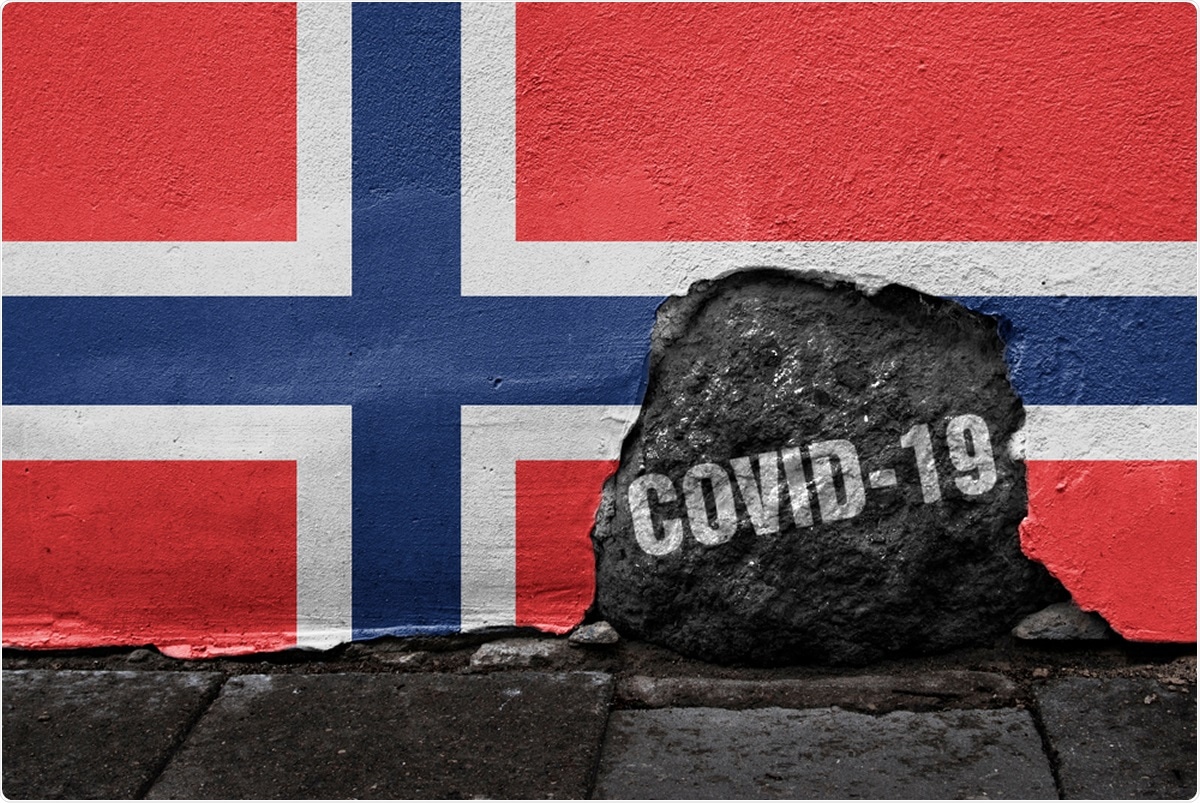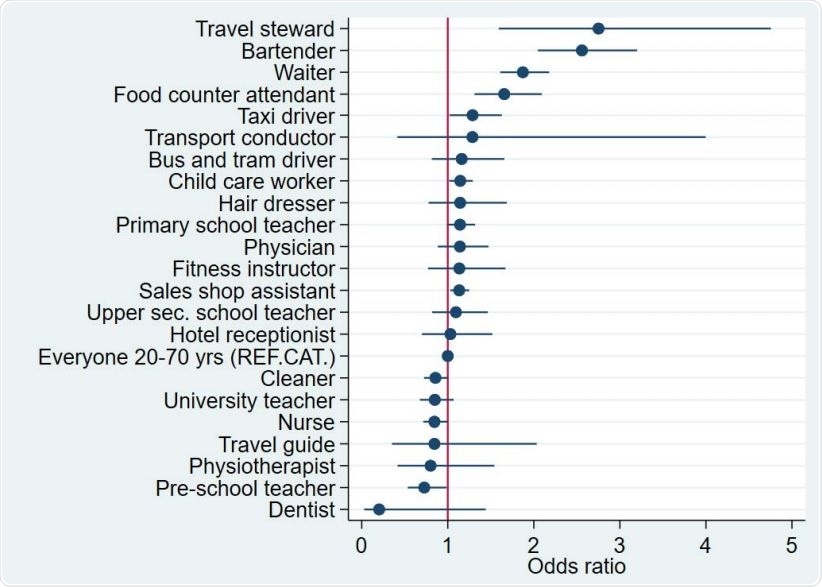During the first wave of the coronavirus disease 2019 (COVID-19) pandemic, many individuals around the world were asked to stay at home. As a result, many businesses’ services and activities were either reduced or closed down entirely. The pandemic has caused major economic disruption worldwide, particularly for those – like the United States, Italy, and the United Kingdom – that have reported surging cases of severe acute respiratory syndrome coronavirus 2 (SARS-CoV-2); the causative pathogen responsible for COVID-19.

Study: Occupational risk of COVID-19 in the 1st vs 2nd wave of infection. Image Credit: bekulnis / Shutterstock
They found that nurses, dentists, physicians, physiotherapists, taxi drivers, and bus drivers were 1.5 to 3.5 times more likely to be infected with COVID-19 during the first wave of the outbreak than everyone else in their working age. Meanwhile, on the second wave of infection, waiters, bartenders, travel stewards, food service counter attendants, and taxi drivers had 1.5 to 4 times the odds of COVID-19 infection.
The study
The study, which recently appeared on the pre-print server medRxiv*, aims to determine whether employees in occupations that typically involve close contact with other people are at a higher risk of COVID-19 and related hospitalization for the first and second wave of infection in Norway.
To arrive at the study’s findings, the researchers gathered data from the BREDT C19 register, a newly developed emergency preparedness register that aims to provide information about the spread of COVID-19. It contains patient records from all hospitals in Norway, which helped the researchers have a glimpse of the situation in the country.
The team’s data also included results from the first positive polymerase chain reaction (PCR) tests for SARS-CoV-2 of every resident in the country, including the dates of testing and diagnosis. Further, the team was able to determine the occupation of the patients included in the study, which can help shed light on those who are at a higher risk of being infected.

The odds (95% confidence interval) of COVID-19 during the 1st wave of infection in Norway (Feb 26th-July 17th 2020), adjusted for age, sex and country of birth. Everyone in their working age (20-70 year) was the reference category (OR==1, vertical red line).
What the study found
Of the more than 3.55 million persons between the ages of 20 and 70 living in Norway, 51 percent are men and 78.8 percent were born in Norway. By October 20, more than 12,000 had been infected with SARS-CoV-2, and of these, 7.5 percent were admitted to the hospital due to severe illness.
The team also found that persons employed as nurses, physicians, dentists, physiotherapists, bus, tram, and taxi drivers were 1.5 to 3.5 times more likely to be infected with COVID-19 during the first wave of infection than others in their working age. Meanwhile, teachers of students at any age, child care workers, bartenders, sales shop assistants, cleaners, waiters, hairdressers, fitness instructors, hotel receptionists, transport conductors, and travel guides had no heightened risk of infection.
Now, amid a second wave of the infection, the occupations with the highest odds of being infected include bartenders, waiters, travel stewards, taxi drivers, and food service attendants. However, many occupations, the study finds, have no increased risk of infection, including teachers of children and students at any age, child care workers, fitness instructors, hairdressers, bus drivers, hotel receptionists, sales shop assistants, and health personnel such as nurses, physicians dentists, and physiotherapists.

The odds (95% confidence interval) of COVID-19 during the 2nd wave of infection in Norway (July 18th - October 20th 2020), adjusted for age, sex and country of birth. Everyone in their working age (20-70 year) was the reference category (OR==1, vertical red line).
When it comes to the outcome hospitalization with COVID-19 infection, none of the occupations had an increased likelihood of severe COVID-19. But, dentists had a 7 times increased risk ratio, while pre-school teachers, child care workers, and taxi, tram, or bus drivers had a 1 to 2 times increased odds ratio.
“We believe this report is the first to show the COVID-19 risks of specific occupations for the entire working population and everyone diagnosed. Existing reports have considered the associations in smaller populations, have used broad categories of occupations and/or have considered only severe hospital-confirmed COVID-19 or mortality,” the team explained in the study.
The team concluded that the occupations that had the highest odds of being infected during the first wave had shifted during the second wave.
This can be explained by the lockdown orders since, during the first wave, most people were confined in their homes, and businesses were closed. However, when the restrictions were lifted, and people were allowed access to restaurants and other public areas, the workers in these sorts of occupations were exposed to more potential carriers of the virus.
“Our findings may be of relevance to increase the understanding of risk and transmission settings for COVID-19 to contribute to more targeted measures to decrease transmission of COVID-19 in public settings,” the team concluded.

 This news article was a review of a preliminary scientific report that had not undergone peer-review at the time of publication. Since its initial publication, the scientific report has now been peer reviewed and accepted for publication in a Scientific Journal. Links to the preliminary and peer-reviewed reports are available in the Sources section at the bottom of this article. View Sources
This news article was a review of a preliminary scientific report that had not undergone peer-review at the time of publication. Since its initial publication, the scientific report has now been peer reviewed and accepted for publication in a Scientific Journal. Links to the preliminary and peer-reviewed reports are available in the Sources section at the bottom of this article. View Sources
Journal references:
- Preliminary scientific report.
Magnusson, K., Nygard, K., Vold, L., Telle, K.E. (2020). Occupational risk of COVID-19 in the 1st vs 2nd wave of infection. medRxiv. https://www.medrxiv.org/content/10.1101/2020.10.29.20220426v1
- Peer reviewed and published scientific report.
Magnusson, Karin, Karin Nygård, Fredrik Methi, Line Vold, and Kjetil Telle. 2021. “Occupational Risk of COVID-19 in the First versus Second Epidemic Wave in Norway, 2020.” Eurosurveillance 26 (40). https://doi.org/10.2807/1560-7917.es.2021.26.40.2001875. https://www.eurosurveillance.org/content/10.2807/1560-7917.ES.2021.26.40.2001875.